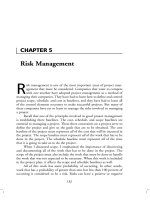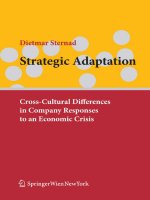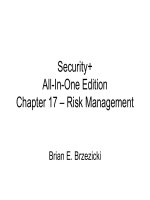Cross cultural management 3rd chapter 17 (5) conflicts and cultural differences
Bạn đang xem bản rút gọn của tài liệu. Xem và tải ngay bản đầy đủ của tài liệu tại đây (145.84 KB, 5 trang )
Slide 17.1
Chapter 17
Conflicts and cultural
differences
Browaeys and Price, Understanding Cross-Cultural Management PowerPoints on the Web, 3rd edition, © Pearson Education Limited 2015
Slide 17.2
Conflict and (cultural) groups
• Cross-cultural conflict involves:
– Cultural groups protecting their own self-image
– Intercultural perceptions coloured by
ethnocentrism and stereotypes
Browaeys and Price, Understanding Cross-Cultural Management PowerPoints on the Web, 3rd edition, © Pearson Education Limited 2015
Slide 17.3
Managing conflict in Malaysia
Core values: durability of personal relations, even
if a strong divergence of opinion results in conflict.
•Concern for face:
– across all ethnic groups
•Concern for others:
– generosity, respect, honesty and sincerity, being upright and
caring
•Respect for seniority:
– in some conflicts a third person, a ‘neutral senior’:
• clarifies key issues subordinates will never confront their superior, will
be uncooperative and eventually resign themselves to the way their
boss behaves.
Browaeys and Price, Understanding Cross-Cultural Management PowerPoints on the Web, 3rd edition, © Pearson Education Limited 2015
Slide 17.4
Managing conflict in Thailand
• The name Thailand – ‘The Land of Smiles’:
– reflects the social harmony in this country.
– A Thai smiles in pleasant and stress-filled situations.
• Smile hides feelings in public:
– self-discipline to maintain status, prestige and face:
•
concept of ‘jai yen’ (‘cool heart’) derived from Buddhism
• Individualism quite predominant:
– but Thais are more ‘relationship-oriented’ than ‘results-oriented’
• Conflict:
– rarely regarded as either positive or negative:
– if a conflict arises, a third party (traditionally a respected elder) is
called upon to mediate.
Browaeys and Price, Understanding Cross-Cultural Management PowerPoints on the Web, 3rd edition, © Pearson Education Limited 2015
Slide 17.5
Managing conflict in (South) Korea
Korea:
-reflects in a way the differences and similarities between
Western and Eastern attitudes to conflict.
•Koreans:
– prefer a non-competitive (or non-dominating) strategy in
face-to-face conflict situations.
– Prefer to use a superior or authoritarian personality
to resolve conflict.
End
Browaeys and Price, Understanding Cross-Cultural Management PowerPoints on the Web, 3rd edition, © Pearson Education Limited 2015









